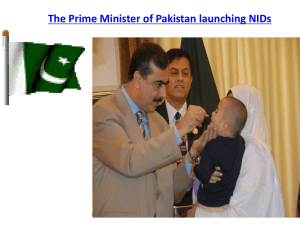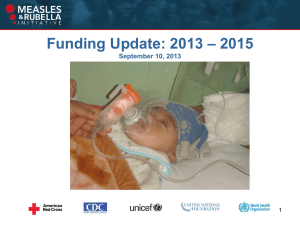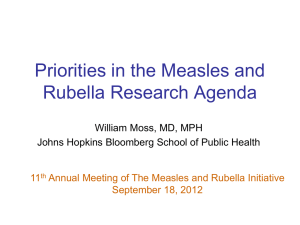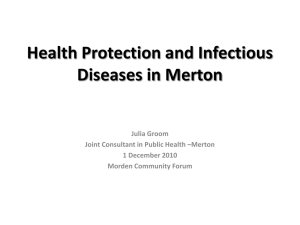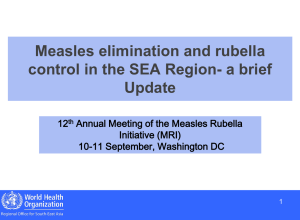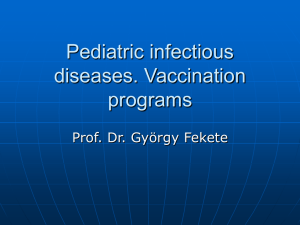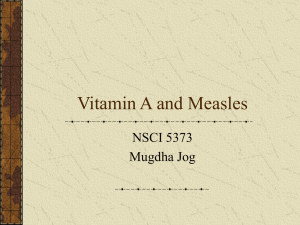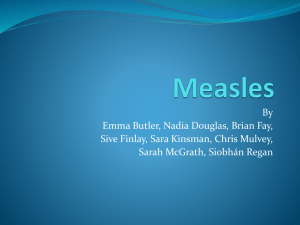Recommendations from the 2010 Global LabNet Meeting
advertisement
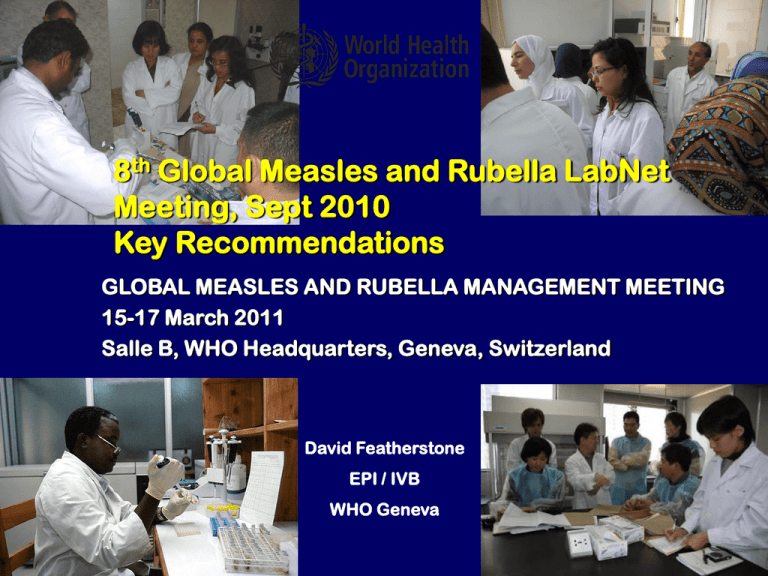
8th Global Measles and Rubella LabNet Meeting, Sept 2010 Key Recommendations GLOBAL MEASLES AND RUBELLA MANAGEMENT MEETING 15-17 March 2011 Salle B, WHO Headquarters, Geneva, Switzerland David Featherstone EPI / IVB WHO Geneva 2 Outline What are the challenges for the LabNet? – – – – – – Implications for achieving Elimination Quality Indicators Reporting data Quality Assurance New Laboratory Procedures Funding Summary WHO Vaccine Preventable Disease Lab Network 3 3 Global LabNet Meeting Participants WHO Vaccine Preventable Disease Lab Network 4 Implications for LabNet in achieving Elimination Indicators (WER No 49, 2010, 85, 490-495) ELISA IgM testing: – ≥ 2/100,000 (non-measles rash/fever cases) per year & ≥ 80% serum samples collected Workload increase estimated extra ~50,000 cases / yr Mainly Pakistan and India moving to case based surveillance India planning 3 new labs 2011 (~$100,000) LabNet has proven surge capacity – Measles IgM cost ~ $ 3 -11 per sample (depending on batch size) – Rubella IgM cost ~ $ 4.50 -17 per sample WHO Vaccine Preventable Disease Lab Network 5 Implications for LabNet in achieving Elimination Indicators (WER No 49, 2010, 85, 490-495) Virus detection: – Measles elimination: The absence of endemic measles cases: – Re-establishment of endemicity: continuous transmission of indigenous measles virus for a period of > 12 months: – >80% of laboratory-confirmed measles outbreaks have adequate samples for virus characterization in an accredited lab WHO Vaccine Preventable Disease Lab Network 6 Current challenges for improving molecular surveillance African region: – Building molecular capacity in Uganda and CIV Molecular surveillance gaps: – Sequencing capacity available but limited sample collection for virus detection – Enhanced molecular surveillance using Oral fluid Trials in India, Benin, CIV, Kenya, Malawi and Zimbabwe WHO Vaccine Preventable Disease Lab Network Molecular surveillance recommendations Reference and sequencing laboratories – determine their capacity to reach surveillance indicators – determine the additional resources needed Laboratory and field surveillance programmes – collaborate to enhance molecular surveillance Greater molecular capacity needed with documented accuracy – training programmes – molecular proficiency programme established Data Reporting Data Issues: Measles and Rubella Laboratory Tested Cases Reported to WHO HQ 2010* WHO region Member states reporting (expected) Rubella 2010 Specimens received Tested Positive Tested Positive AFR 31 (46) 18,151 18,151 6,757 12,605 1,963 AMR 30 (35) 11,582 5,347 22 5,678 134 EMR 21 (21) 12,242 11,615 3,873 9,760 1,042 EUR 46 (53) 27,110 22,325 4,994 21,590 936 SEAR 11 (11) 5,284 4,968 1,697 3,524 1,547 WPR 12 (27) 16,897 15,658 4,141 13,617 3,606 Total 153 (193) 91,266 78,064 21,484 66,774 9,228 Data source: surveillance DEF file Data in HQ as of 8 Jan 2011 9 Measles 2010 * As of Jan 2011 WHO Vaccine Preventable Diseases Lab Network Data Issues: Measles and Rubella Laboratory Tested Cases Reported to WHO HQ 2010* WHO region Member states reporting (expected) Specimens received Tested Positive 6,757 Rubella 2010 Tested Positive South Africa outbreak 18,359 laboratory 12,605 1,963 confirmed 2010 AFR 31 (46) 18,151 18,151 AMR 30 (35) 11,582 5,347 EMR 21 (21) 12,242 11,615 3,873 9,760 1,042 EUR 46 (53) 27,110 22,325 4,994 21,590 936 SEAR 11 (11) 5,284 4,968 1,697 3,524 1,547 WPR 12 (27) 16,897 15,658 Total 153 (193) 91,266 78,064 Data source: surveillance DEF file Data in HQ as of 8 Jan 2011 10 Measles 2010 * As of Jan 2011 WHO Vaccine Preventable Diseases Lab Network ~ 50,000 (2008) 22 / year 5,678 134 China not reporting 3,606 4,141 13,617 21,484 66,774 9,228 22,037 from Country reports Data reporting: Recommendations LabNet encouraged to work with their national surveillance programmes to reconcile laboratory and field surveillance data Data sent to WHO according to agreed upon reporting requirements Sequencing data reporting 13 WHO Global genotype databases: Current Status Viruses submitted dating from 1954 to 2011 Data as of 28 Feb 2011 WHO Database No. of viruses Genotypes Countries and Territories WHO Regions Proportion with GenBank entries Measles 8912 23 + 1 prov. 131 6 37% Rubella 773 9 + 4 prov. 44 6 36% MeaNS database (HPA/WHO) N – 450bp – 5542 sequences N – full – 5 sequences H – full – 503 sequences WHO Vaccine Preventable Disease Lab Network Measles Genotype data submitted to WHO Database 1600 Total number of countries submitting virus data per year Number of countries submitting virus data per region 58 1400 55 6 64 1200 55 4 57 8 1000 9 WPR SEAR EUR Number of viruses submitted 10 14 800 2 24 31 600 11 3 39 3 4 EMR AMR AFR 21 30 13 22 400 20 26 3 4 200 17 12 9 0 2002 2003 2004 2005 2006 2 2007 Year of onset WHO Vaccine Preventable Disease Lab Network 10 3 9 2008 9 2 19 2009 10 3 17 2010 10 2011 2010 incidence 2010 Distribution of measles genotypes West Africa inset West Europe inset Genotype: Incidence: (per 100'000) B2 <0.1 B3 ≥0.1 - <1 D4 ≥1 - <5 D5 ≥5 D8 No data reported D9 H1 Chart proportional to number of genotypes 5 1 The boundaries and names shown and the designations used on this map do not imply the expression of any opinion whatsoever on the part of the World Health Organization concerning the legal status of any country, territory, city or area or of its authorities, or concerning the delimitation of its frontiers or boundaries. Dotted lines on maps represent approximate border lines for which there may not yet be full agreement. China: Measles isolates and genotyping results, 2009 2009: 270 cases H1a measles virus reported to database D9 (1 case) D4 (1 case) Yunnan d11 (17 cases) Unpublished data provided by Xu Wenbo 17 17 Recognition of new genotypes d11 MVi/Menglian.Yunnan.CHN/47.09/1. Virus to be provided by China CDC. Genotype B3 sequences from Libya, Tunisia and Sudan should be considered as a third cluster in genotype B3. Virus to be provided by Institut Pasteur de Tunis. Reference viruses for Rubella genotypes 1h, 1i, and 1j have been identified. These viruses to deposited in the WHO rubella virus strain banks The recent changes in the list of recognized rubella and measles genotypes should be published in the WER A steering committee to be formed to review and refine the protocols for accepting and distributing sequence information via MeaNS and the WHO Database WHO should develop a mechanism for rapidly notifying LabNet of important developments such as detection of a new lineage or genotype WHO Vaccine Preventable Disease Lab Network Higher resolution sequencing D6 strains in Germany and Belarus Data Provided by Luxemburg Laboratory N gene NPH gene 1 month Recommendation: Select laboratories to evaluate and identify when appropriate to 6 months implement UKR BEL UKR 20 20 Quality Assurance LabNet Proficiency test performanceMeasles IgM Panels Panel No. ≥ 90% correct (Pass) 00801 n=46 (2001) 96% 00702 n=17 (2002) 88% 01002 n=66 (2003) 95% 00703 n=99 (2004) 90% 00704 n=115 (2005) 94% 00508 n=142 (2006) 98% 00607 n=164 (2007) 98% 00705 n=173 (2008) 99% 00805 n= 171 (2009) 98% 00905 n= 220 (2010) 99% 22 Quality Assurance Recommendations More comprehensive analysis of IgM proficiency testing and reporting Introduction of proficiency test for molecular techniques More comprehensive training & post training assessments WHO Vaccine Preventable Disease Lab Network New Procedures 24 24 Point of care rapid measles assay The measles rapid point of care (POC) shows promising sensitivity and specificity compared with detection of IgM in serum WHO Vaccine Preventable Disease Lab Network POC to be further validated using oral fluid samples collected under routine field conditions Documentation of new procedures Alternative samples to serum for measles and rubella M & R PCR QC programme QC for Oral fluid Real time PCR; M & R 25 Standards for measles serosurvey New sequencing primers for measles and rubella Rapid Point of care assays Validated and in process of implementation WHO Vaccine Preventable Disease Lab Network In process of validation Funding Current LabNet Estimated Costs $1,600,000 $1,400,000 $1,200,000 Estimated shortfall $1,300,000 Shortfall Funds Identified 2011 $1,000,000 27 $800,000 $600,000 $400,000 $200,000 $0 Lab Support Meetings Consumables Kits WHO Vaccine Preventable Disease Lab Network Training Travel Equipment Funding recommendations LabNet should endeavour to find additional resources and new partners Countries encouraged to include laboratory support in their surveillance budgets Additional funds for training, to: – Maintain the current high level of LabNet performance – Strengthen sequencing capacity Summary LabNet has capability to meet increased surveillance needs – Some capacity will need to be developed Capacity building and extra testing comes at a cost, not all of which is realised 30 Thank you to all our LabNet Supporters CDC WHO Korean CDC National MsOH IFFIM Luxemburg Gov't Merck Measles Initiative HPA Labs belonging to LabNet WHO Vaccine Preventable Disease Lab Network Programmes sharing resources Polio JE YF
